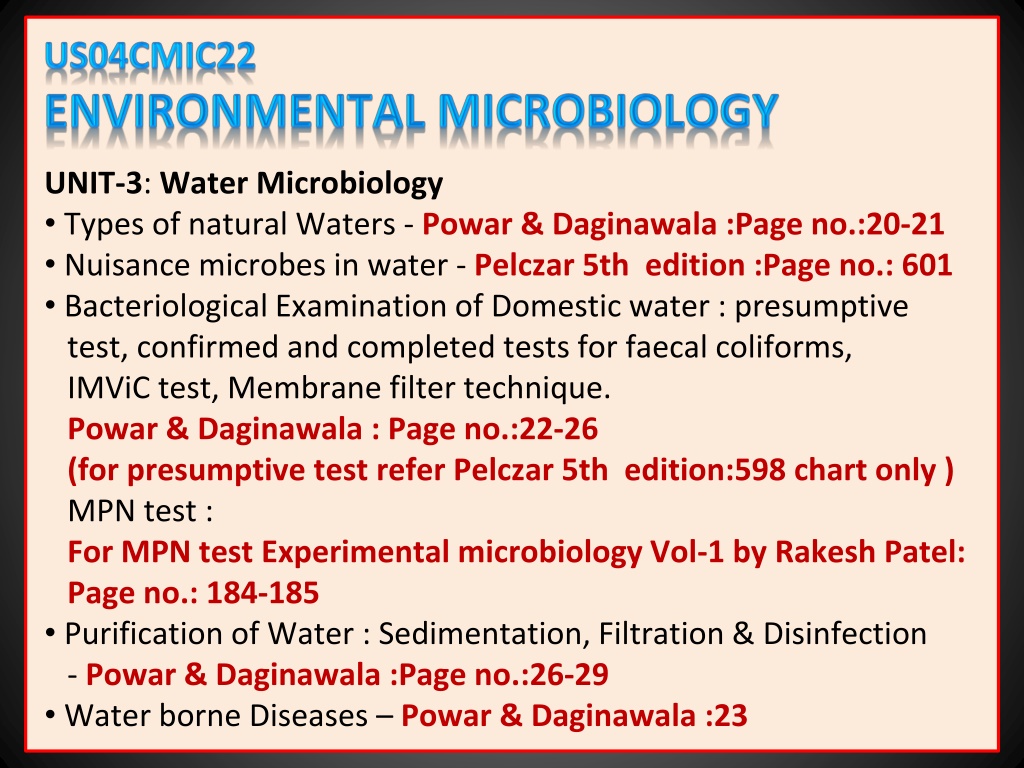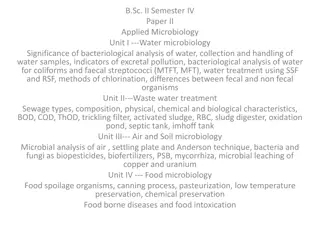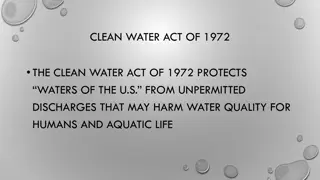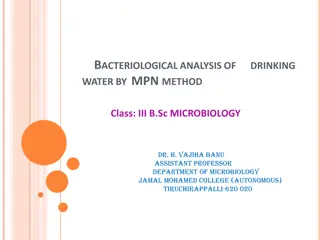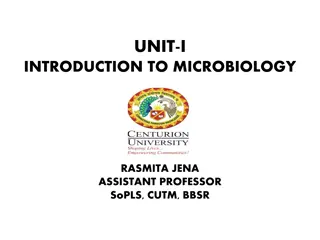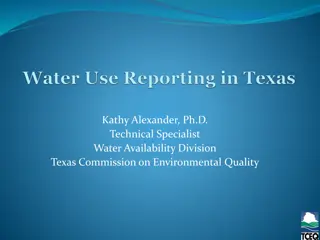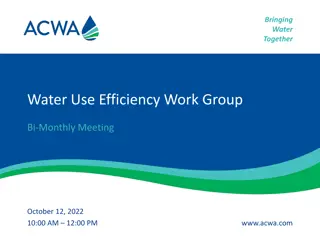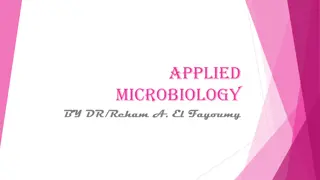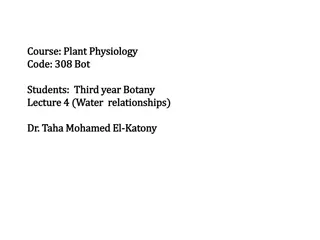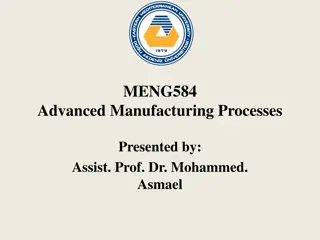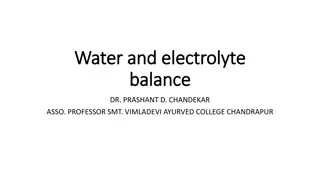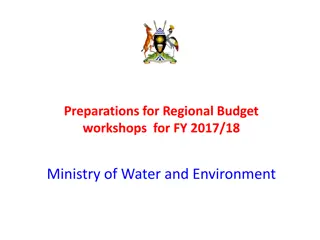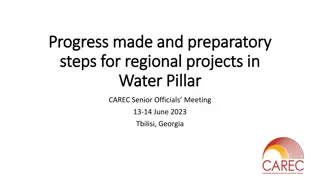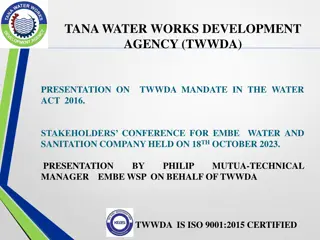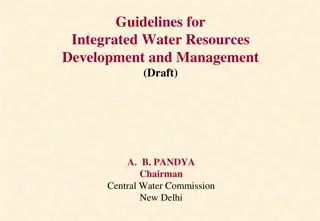Understanding the Diversity of Natural Waters in Water Microbiology
Water is essential for life and plays a vital role in the ecosystem. This article explores the various types of natural waters, including atmospheric waters, surface waters, stored waters, and ground waters. Each type harbors different microbial populations influenced by factors such as climate, geography, and biological activities. The presence of microorganisms in water poses challenges, leading to the need for bacteriological examinations and purification techniques to prevent waterborne diseases.
- Natural Waters
- Water Microbiology
- Microbial Populations
- Bacteriological Examination
- Waterborne Diseases
Download Presentation

Please find below an Image/Link to download the presentation.
The content on the website is provided AS IS for your information and personal use only. It may not be sold, licensed, or shared on other websites without obtaining consent from the author. Download presentation by click this link. If you encounter any issues during the download, it is possible that the publisher has removed the file from their server.
E N D
Presentation Transcript
UNIT-3: Water Microbiology Types of natural Waters - Powar & Daginawala :Page no.:20-21 Nuisance microbes in water - Pelczar 5th edition :Page no.: 601 Bacteriological Examination of Domestic water : presumptive test, confirmed and completed tests for faecal coliforms, IMViC test, Membrane filter technique. Powar & Daginawala : Page no.:22-26 (for presumptive test refer Pelczar 5th edition:598 chart only ) MPN test : For MPN test Experimental microbiology Vol-1 by Rakesh Patel: Page no.: 184-185 Purification of Water : Sedimentation, Filtration & Disinfection - Powar & Daginawala :Page no.:26-29 Water borne Diseases Powar & Daginawala :23
Types of natural Waters Water has curious and unusual properties, and plays an important role in living system. This, "No life without water" is a common saying It is a master solvent, and all metabolic reactions of living organism depend on the presence of water. Nearly three fourths of the earth surface is covered by water, mainly ocean, and to lesser degree by rivers, lakes, and streams. This water is in continuous circulation, the process is known as the water cycle or hydrologic cycle. Water is lost from the earth by the way of evaporation, transpiration and exhalation, and is returned to the earth by the way of precipitation. Microorganisms get into natural waters from air, soil, sewage, organic wastes, dead plants and animals, etc. Thus almost any type of organisms may be found in water.
NATURAL WATERS Natural waters are commonly grouped into four classes: (1) atmospheric waters (2) surface waters (3) stored waters and (4) ground waters (1) Atmospheric waters Rain, snow and hail which fall on land tend to carry down particles of dust, soot, and other materials suspended in the air. These often bear bacteria and other microorganisms on their surface. The number of organisms depends upon local conditions. After heavy rain or snow the atmosphere is washed free of organisms.
(2) Surface waters As soon as rain or snow reaches the earth and flows over the soil, some of the soil organisms are gathered up by the water. Bodies of water such as streams, rivers, and oceans represent surface water. Microbial populations depend upon their numbers in the soil and, also, upon the kinds and quantities of food material dissolved out of the soil by water. Climatic, geographical and biological conditions bring about great variations in microbial populations of surface waters. Rivers and streams show their highest count during the rainy period. Dust blowing into rivers and streams also contributes many microorganisms. Animals also make considerable contribution to the microbial flora of the surface Waters. They bath and often drop their excreta in the water.
(3) Stored waters Inland waters held in ponds, lakes, or reservoirs represent stored waters. Storage generally reduces the numbers of organisms in water. A certain degree of purity and stability is established. Several factors affect the microbial flora of stored waters. These are as follows : Sedimentation Microorganisms have a specific gravity slightly greater than that of water, and therefore slowly settle down. However, the most important factor is their attachment to suspended particles. Microorganisms are removed from the upper layers of the water as the suspended particles settle down. Activities of other organisms Predatory Protozoa engulf living or dead bacteria for food, provided the water contains sufficient dissolved oxygen.
Light rays Direct sunlight is toxic to both vegetative cells and spores of microorganisms. The toxicity of ultraviolet rays is inversely proportional to the turbidity of water. In tropical countries direct sun light is a very effective sterilizing agent. Temperature. Temperature has variable effects. It may kill some organisms and may stimulate the growth of others. During colder months the multiplication rate of microorganisms is considerably reduced. Food supply If there is considerable vegetation or suspended food particles in the body of water, it is likely to increase the number of organisms. On the other hand, certain toxic substances may bring about marked reduction in the number of organisms.
(4) Ground waters As water seeps through the earth, microorganisms as well as suspended particles are removed by filtration in varying degrees. This depends on the permeability characteristics of the soil and the depth to which the water penetrates. Ground water brought to the surface by springs or deep wells contains very few organisms. To construct a well the nature of the soil and underlying porous strata, the nature of the water table, and the nature, distance, and direction of the local sources of pollution must be taken into consideration.
Nuisance microbes in water Microorganisms Other Than Coliform Bacteria Some microorganisms besides coliform bacteria are of Intestinal origin and could also be used as indicators of fecal contamination of water, such as the fecal streptococci. Other intestinal microorganisms, such as intestinal viruses are frank pathogens and can cause serious diseases. Still other microorganisms are regarded mainly as nuisance organisms, because they create problems of odor, color, and taste, or cause obstruction of water flow. Fecal Streptococci Fecal streptococci are enteric bacteria found in the intestines of warm-blooded animals, including humans. Streptococcus faecalis is representative of this group: other species are S. faecium, S. bovis and S.equinus. Because fecal streptococci, particularly, S. faecalis, are abundantly present in the large intestines of humans, their occurrence in water is indicative of fecal pollution.
Slime-Forming Bacteria Many bacteria are capable of elaborating gummy or mucilaginous materials, either as capsular structures or as extracellular excretion products. The organic and inorganic constituents of the water, which provide nutrients for the bacteria. help to determine whether slime is produced and what organisms are responsible for its production. Iron Bacteria The iron bacteria are one of the most important types of nuisance organisms in water. They transform soluble compounds of iron to insoluble compounds of iron (ferric hydroxide) which may be deposited in a sheath around the organism (Sphaerotilus) or secreted so as to form stalks or ribbons attached to the cell (Gallionella). This deposition and accumulation of insoluble material in the piping system may eventually have a significant effect on the rate of water flow. Iron bacteria can also produce slime, discolor water, and cause undesirable odors and tastes.
Sulfur Bacteria Some of the sulfur bacteria are capable of producing and tolerating extreme acidity, Organisms of the genus Thiobacillus oxidize elemental sulfur to sulfuric acid and can produce an acidity in the range of pH 1; thus they may be responsible for the corrosion of pipes. Desulfovibrio desulfuricans reduces sulfates other sulfur compounds to hydrogen sulfide. Algae When water is exposed to sunlight, algal growth often results; the occurrence of algae in water is much like the growth of weeds in a garden. Algae are present in all natural aquatic environments. Their nuisance characteristics involve production of turbidity, discoloration, odor, and taste in water. Algae are frequently the primary cause for the clogging of filters during water purification. The diatoms are the most important in this respect, although green and yellow algae are also involved. Aside from these nuisance characteristics, some algae are capable of producing substances toxic to humans and animals.
Viruses Many viruses are known to be excreted from humans through the intestinal tract, and these may find their way via sewage into sources of drinking water. The enteroviruses are the ones most commonly found in sewage; they include the polio, coxsackie, and echo viruses. The virus that causes infectious hepatitis has been isolated from polluted water and shellfish; occurrence of this disease has been traced to these sources. Rotaviruses are also of major importance. The possibility that virus diseases, particularly the enteric virus diseases, may be waterborne indicates that methods for evaluating the potability of a water supply from a virological standpoint should be developed. Considerable research is underway for the development of a routine test method for the detection of viruses in water and wastewater. At the same time more attention is being given to the assessment of the effectiveness of water treatment processes for the removal and/or inactivation of viruses.
Bacteriological Examination of Domestic water : (Presumptive test, Confirmed and Completed tests for faecal coliforms, IMViC test, Membrane filter technique) Introduction: Natural water supplies such as rivers, lakes, and streams contain sufficient nutrients to support growth of various organisms. Microorganisms enter the water supply in several different ways. In congested centers water supplies get polluted by domestic and industrial wastes. As a potential carrier of pathogenic microorganisms, water can endanger health and life. From the standpoint of transmitting human diseases, polluting waters with soil, rubbish, industrial wastes, and even animal manure is comparatively harmless. These sources rarely contain pathogens capable of producing human diseases when swallowed with drinking water.
Sewage containing human excreta, however, is the most dangerous material that pollutes water. People with communicable diseases of many kinds eliminate the causative organisms in their excreta. The most important microbial diseases transmitted through water are typhoid fever, paratyphoid fever, amoebic dysentery, bacillary dysentery, cholera, tularem, poliomyelitis, and infectious hepatitis. Majority of bacteria found in water belong to the groups of coliforms, Pseudomonas and Proteus group, plant pathogens, and the spore formers of the genus Bacillus and Clostridium. Potable water or drinking water, is defined as the water which is free from pathogenic microorganisms and chemicals that are deleterious to human health However, other factors such as taste. odor and color must be absent if water is to be potable.
Water contaminated with either domestic or industrial waste is called non-potable or polluted water. To determine the potability of water quantitative bacteriological examination may be undertaken. However, there is no single test or, even combination of tests, that is wholly satisfactory, because it will give only a fraction of the total count. Theoretically it would be better to examine water for the presence of the specific pathogenic microorganisms. This is also impracticable because of the following reasons : 1. The methods are expensive, tedious, and slow, and by that time the water has already been consumed. 2. The number of pathogenic organisms may be quite small compared to non-pathogenic organisms and would be overlooked. 3. Non-pathogenic organisms may interfere with the examination of pathogens.
The direct examination for pathogens, therefore, is not used in routine water analysis. Methods commonly used for the bacteriological examination of water, are based on: 1. The examination of presence or absence of the more common organisms of intestinal or sewage origin.(Qualitative method) 2. The approximate determination of total numbers of bacteria present in the water sample.(Quantitative method)
MICROBIAL INDICATORS OF FAECAL CONTAMINATION Hence, detection of a specific pathogen would constitute the most direct evidence of faecal contamination. However, this is impractical because of following reasons. Drinking water should be free of any pathogenic organisms. 1. There are numerous gastrointestinal pathogens, each requiring different method for isolation 2. Numbers of pathogens are less as compared to non-pathogens and may escape detection. 3. Non-pathogenic organisms may interfere with examination of pathogens. indicator organisms as an index of possible contamination by human pathogens. Due to the above limitations, sanitary microbiologists use
tract of humans and animals are considered as indicator organisms. That includes faecal coliforms (Escherichia coli), faecal group D streptococci (Streptococcus faecalls), and Clostridium perfringens. Recently, some other members of the anaerobic intestinal flora, notably Bifidobacterium spp. have been proposed as an additional indicator bacteria Several organisms which are commonly found in intestinal
COLIFORM BACTERIA Coliforms are the members of the family Enterobacteriaceae, it includes several genera like Escherichia, Citrobacter, Klebsiella and Enterobacter. Coliforms are defined as facultatively anaerobic, gram-negative, non sporing, rod shaped bacteria that ferment lactose with acid and gas formation within 24-48 hours at 37 C. Coliforms include number of different organisms. 1. Those referred to as typical or faecal (E.coli) are commensal of the intestine and are derived almost exclusively from this habitat. 2. Others, known as atypical (Enterobacter, Klebsiella and Citrobacter) may also grow in soil and on vegetation and hence may often be present in water which is not fecaly contaminated. Thus in carrying out the test for coliform bacilli in water it is necessary to determine whether the strains present are typical or atypical.
Escherichia coli as an indicator organism Among so many indicator organisms, faecal coliforms i.e. E.coli has found the most wide spread use as an indicator organism due to the following reasons. 1. E.coli is a normal flora of intestinal tract of healthy humans. 2. E. coliis excreted in large numbers in human faeces (~ 5 x 107 organisms/gram ). As a result there are high chances of detecting the organism even after high dilutions. 3.E.coli are derived almost exclusively, from intestine of humans. 4. Survival rate of E.coli is longer than that of any gastro-intestinal pathogen. 5. Isolation of E.coli is relatively very easy as well as it is non- pathogenic and harmless.
TESTS FOR DIFFERENTIATION OF COLIFORMS (1) IMVIC test As stated earlier it is essential to differentiate between typical and atypical coliforms. The differentiation is based on the basis of four biochemical tests, known as IMVIC tests. The letter I stands for indole test, M for methyl red test. V for Voges-Proskauer test and C for citrate test. The letter i between V and C is added solely for euphony. On the basis of these four tests, the coliforms are differentiated as follows. Tests E.coli Enterobacter aerogens Indol + - Methyl red + - Voges-Proskauer - + Citrate - +
Test E. coli E.aerogenes Indole Indole is produced Not produced(-) from tryptophan (+) Methyl Red Methyl red is turned red, Methyl red remains which means a pH of yellow, which means below4.5 is produced(+) less acid produced(-) Voges-Proskauer Acetyl methyl carbinol Acetyl methyl is not produced in carbinol is glucose peptone produced(+) medium(-) Citrate Citrate as the sole Supports the source carbon does growth(+) not support growth(-)
(2)Elevated temperature (Eijkman's) test Another test used for the differentiation between typical and atypical coliforms is on the basis of the growth at elevated temperature. E. coli is able to grow at a temperature of 44 C while the growth of En. aerogenes is inhibited at this temperature. STANDARDS FOR DRINKING WATER QUALITY (a) Qualitative: The most stringent standards are imposed on drinking water. According to the World Health Organization (WHO), water should be condemned if it is found to contain more than 10 coliforms or 1 E. coli per 100 ml. Hence, if there are 2 E. coli per 100 ml water becomes unsuitable for drinking purposes. Thus minimum amount of water sample needed for analysis is 50 ml (which will theoretically contain at least 1 E.coli. (b) Quantitative: 100 microorganisms / 1ml of water is suitable for drinking purpose and more than 100 microorganisms/1ml is unsuitable for drinking purposes.
BACTERIOLOGICAL ANALYSIS OF WATER American Public Health Association (APHA) in their book, titled, "Standard Methods for Examination of Water and Waste Water", have described specific techniques for routine bacteriological analysis of water. All these methods are widely recognized and followed by all the sanitary agencies and health laboratories throughout the world. Accordingly, the routine bacteriological procedures consist of: 1. Standard plate count (SPC) or total viable count (TVC). (Quantitative) 1. Test for coliforms. (Qualitative) 2. Enumeration of coliforms. (Qualitative)(MPN)
STANDARD PLATE COUNT (SPC) OR TOTAL VIABLE COUNT (TVC) It is a quantitative bacteriological analysis which enumerates total viable population capable of growing under a given set of conditions. Plate counts are useful in determining the efficiency of water/waste water treatment. It is assumed that water of a good quality properly treated) should give counts less than 100 colonies per milliliter. Principle TVC / SPC is based on the assumption that each viable bacterium develops into a distinct colony. Hence, original number of microorganisms in the sample can be calculated from number of colonies and then multiplying it with aliquot factor.
Limitations of viable count: 1. There is not a single set of incubation conditions and a medium composition that would permit growth of all bacterial types. 2. Several organisms if stuck together in a clump (in chains or in clusters) will give rise to a single colony. Because of above limitations it is not possible to be absolutely certain that each colony arose from an individual cell, hence results are often expressed in terms of colony forming units (CFU), rather than the number of microorganisms. Requirements 1. Water sample. 2. Sterile distilled water dilution tubes (4.5 ml or 9.0 ml). 3. Sterile melted nutrient agar tubes. 4. Sterile Petri dishes and sterile 1 ml pipettes.
Procedure 1. Prepare 10-1,10-2 and 10-3.... dilutions of the water sample (if necessary). 2. From each of the dilution transfer a fixed amount (e. 0.1 ml) into sterile melted nutrient agar tube (previously cooled to 50 C), mix it well and pour immediately in sterile Petri dishes. 3. Label plates (e.g. as 10-1 / 0.1 or as the case may be), clearly indicating the dilution and the volume plated respectively. Incubate all plates at 37 C for 24 hours. 4. Count total number of colonies that has developed on each of the plate. If necessary use colony counter to help counting of colonies. 5. Calculate final number of organisms present in the water sample as follows.
Calculations & interpretation of results 1. For accuracy of results, countable plates are those which have colonies in between 30-300. Fewer than 30 colonies are not acceptable for statistical reasons, and more than 300 colonies on a plate is likely to produce colonies too close to each other to be distinguished as individual CFUs. 2. Lower dilutions (e.g. 10-1,10-2) at times may show confluent (lawn) growth, due to high load of organisms in the sample, these results are represented as "too numerous to count" (TNTC). 3. Final CFUs / ml can be calculated by multiplying the average number of colonies per countable plate by the reciprocal of the dilution and the reciprocal of the volume plated. CFUs /ml = Average number of colonies x Volume plated Dilution
TEST FOR COLIFORMS Todetect coliforms, a three stage procedure (the presumptive test, confirmed test, and completed test) is carried out in systematic order according to the results of each step. PRESUMPTIVE TEST Principle It is based on the principle that coliforms if present in water, will ferment lactose to produce acid and gas within 24-48 hours. Production of acid is indicated by pH Indicator and gas is collected in Durham's vial, both of which are present in the medium. Media used are highly selective for coliforms, which inhibit growth of gram-positive organisms. MacConkey's lactose bile broth (MLBB) or laurel tryptose broth or brilliant green lactose bile broth (BGLB) can be used for presumptive test.
Different volumes of water are inoculated in MLBB or BGLB which permits growth of coliforms only. Coliforms will ferment lactose to produce acid and gas within 24-48 hours and test is considered as positive. Hence, it may be presumed that coliforms may be present in water hence the name presumptive test. Requirements 1. Water sample. 2. Sterile 1 ml and 10 ml pipettes 3. 5 MLBB tubes, each with 10 ml double strength medium (2X) 4. 3 MLBB tubes, each with 5 ml single strength medium (X). Procedure 1. Shake the water sample vigorously to ensure uniform distribution of organisms. 2. With sterile graduated pipettes inoculate the water sample as follows.
5 MLBB double strength tubes with 10 ml water. 1 MLBB single strength tube with 1.0 ml water. 1 MLBB single strength tube with 0.1 ml water 3. One tube of MLBB single strength is not inoculated and hence, serves as control. 4. Incubate all tubes at 37 C for 24 hours. 5. Examine tubes for the presence of acid and gas after 24 hours. 6. If no gas has formed, reincubate all the tubes for another 24 hours (total 48 hours). 7. Record the presence or absence of acid & gas at each examination, & interprete as follows: Interpretations 1. Absence of gas even after 48 hours indicate a negative test and the presumptive test is terminated. The water sample is assumed to be potable. 2. Presumptive test is considered positive if any one or more of tubes show acid and gas. Positive tubes are retained for confirmed test.
Flow chart of Presumptive Test Inoculate 9 Tubes : 3 MLBB (2X) with 10 ml, 3 MLBB (X) with 1 ml and 3 MLBB (X) with 0.1 ml water sample Incubate all tubes at 37 C for 24 hours Negative: All tubes show no color change and absent of gas in Durham's vial Positive: Any or More tubes show color change and present of gas in Durham's vial
Note: 1. Double strength broth: (contains double the concentration of ingredients except water) is used when large volumes of water are to be inoculated, because the medium would otherwise be too diluted and may not support the growth of bacteria. 2. False positive presumptive test may be produced due to: (a) Presence of lactose fermenting organisms other than coliforms. (b) A synergistic association where the joint action of two organisms on a carbohydrate re suits into production of gas which will not be formed by either species when grown separately. Synergism is frequently caused by a joint action of gram-positive and gram-negative organisms growing together, e.g. Staphylococcus aureus and Proteus vulgaris False positive presumptive test can be overcome by adding bile salts and triphenylmethane dyes which inhibit growth of gram-positive bacteria and thereby eliminate synergistic effect. 3. Over fermentation: this kind of results are obtained when ratio of number of organisms to the amount sugar is comparatively very high. Due to less amount of sugar, acid produced is not sufficient enough to lower the pH at which growth organism is inhibited. Thus. growth continues and organisms switch over to peptones when sugars are depleted. Since end products of protein metabolism are alkaline in nature the basicity of medium increases. Hence, MLBB appears yellow even though the test is positive.
CONFIRMED TEST This test is named so because, positive presumptive tubes having acid and gas are subjected to further confirmation that positive results were due to coliforms only. Test involves, streaking of Eosin methylene blue (EMB) agar or Endo's agar plate and looking for the growth of typical &/or atypical colonies of coliforms. Requirements 1. Positive presumptive tube(s). 2. EMB agar plate, BGLB Procedure 1. Streak EMB agar plate with a loopful of suspension from a positive presumptive tube (which shows the highest amount of gas production), so as to get well isolated colonies. 2. Inoculate one drop in BGLB. 3. Incubate the plate at 37 C for 24 hours, 4. Record results and interprete them as follows.
Flow chart of Confirm test Streak EMB agar plate Inoculate BGLB Incubate EMB agar plate and BGLB at 37 C for 24 hours Growth with greenish metallic sheen indicate positive confirm test BGLB show gas production in Durham's vial indicate positive confirm test
Interpretations EMB agar plate permits three types of colonies to develop: 1. Typical: Small nucleated with or without greenish metallic sheen. 2. Atypical: large, opaque, pink, non-nucleated, mucoid which tend to merge with each other. 3. Negative: all other types of colonies developing on the plate. Growth of typical colonies indicate confirmed test positive and has to proceed for completed test. If only atypical colonies develop, the test can't be considered negative since time, coliforms fail to form typical colonies, or colonies develop slowly, Hence the test should be completed However, if only negative (others) colonies develop on the plate: the confirmed test is recorded as negative and further tests are not necessary.
COMPLETED TEST In this test the typical &/or atypical colonies growing on EMB agar plate are subjected to morphological and biochemical verification so as to prove that they are coliforms. Since this test completes and finishes the presumptive test for coliform s referred to as Completed test. Requirements 1. EMB/Endo's agar plate having typical/atypical colonies isolated from positive presumptive tube. 2. Lactose broth tube (other than the one used in presumptive test e.g.. Brilliant green lactose bile broth (BGLB) or nutrient lactose broth with Andrade's indicator and Durham's vial. 3. Nutrient agar slant.
Procedure 1. Select and mark a well isolated typical atypical colony on EMB or Endo's agar plate 2. With the help of Nicrome wire loop, pick up half of the previously marked typical / atypical colony and transfer it to BGLB or nutrient lactose broth tube. 3. From the remaining half of the same colony streak over the surface of a nutrient agar slant. 4. Incubate slant and broth at 37 C for 24 hours. 5. Check Lactose broth for presence of acid and gas. 6. Prepare Gram's stain of the growth from the surface of agar slant and observe the slide. Look for the presence of gram- negative non-spore forming short rods. 7. Record results and interprete as follows:
Flow chart of Completed test EMB with growth showing greenish metallic sheen Inoculate Lactose broth Streak N-agar slant Incubate Lactose broth and N-agar slant at 37 C for 24 hours After 24 hours perform gram staining from N agar slant. If bacteria are gram negative non spore forming and show acid and gas in lactose broth completed test is positive Color change and present of gas in Durham's vial of Lactose broth indicate positive test
Interpretation 1. Presence of gram-negative, non-spore forming short rods capable of producing acid and gas from lactose indicates the completed test positive. 2. Absence of gram-negative non-spore forming short rods and the absence of acid and gas from the lactose constitutes a negative completed test Conclusion of presumptive test Positive presumptive test indicates presence of coliforms in water sample, which points out the faecal contamination of water, hence the water is non-potable, as it may carry potentially pathogenic microorganisms, However, as stated earlier conforms include wide range of bacteria whose primary source may not be the intestinal tract of human beings: so further dirferentiation of coliforms is recommended.
MULTIPLE TUBE (MOST PROBABLE NUMBER (MPN)TECHNIQUE Principle It is a statistical method based on the probability theory. In this technique, the sample is serially diluted till the number of organisms reach the point of extinsion. From each of these dilutions several multiple tubes of a specific medium are inoculated, Presence of organism is indicated by acid or gas in the medium. Pattern of positive and negative test results are then used to estimate the number of bacteria in the original sample. Since the test gives the most probable number of organisms present in the sample it is also known as MPN test. Requirements 1. 3 MLBB tubes each having 10 ml double strength (2x) medium, 2. 7 MLBB tubes each having 5 ml single strength (X) medium. 3. Sterile 10 ml and I ml pipettes. 4. Water sample to be tested.
Procedure 1. Shake the water sample vigorously to ensure uniform distribution of organisms. 2. Dilute the sample if necessary. 3. With the sterile graduated pipettes inoculate the water sample (diluted sample, if the dilution is done) as follows. (a) 3 Tubes of MLBB having I0 ml (2X) medium with 10 ml of sample each. (b) 3 Tubes of MLBB having 5 ml (X) medium with 1 ml of sample each. (c) 3 Tubes of MLBB having 5 ml (X) medium with 0.1 ml of sample each 4. One tube of MLBB having 5 ml (x) medium is left uninoculated, which serves as control. 5. Incubate all tubes at 37 C for 24 hours. 6. Examine tubes for acid and gas after 24 hours.
7. If no tube shows acid and gas reincubate all tubes for another 24 hours. 8. At the end of the incubation period, record the number of positive tubes in each of three sets (i.e. 10 ml, 1 ml and 0.1 ml). and interprete results as follows. Interpretation MeCrady in 1918 computed tables regarding the most probable number of organisms present in 100 ml of water, on the basis of various combinations of positive and negative results in the amounts used for tests Number of organisms per 100 ml is read from the McCrady's table, and the number is multiplied by the dilution factor (if any), to come to the final number.
The Membrane Filter Method A filtration technique for enumerating, coliform bacteria in water was developed in Germany during World War II, and has been accepted as a standard method. The filtering apparatus is constructed of a glass or stainless steel funnel and a suction flask. A filter disk composed of cellulose derivative is placed in the filtering apparatus. After the sterilized filter apparatus is assembled, a volume of water is passed through the filter disk. The bacteria from the water sample are retained on the membrane filter. The filter disk is transferred with a sterile forceps to a sterile Petridis containing an absorbent pad saturated with an appropriate medium. The medium diffuses trough the pores of the membrane and brings nutrient to the bacteria entrapped during filtration. Upon incubation, colonies of organisms develop upon the filter disk and can be easily counted.
This method possesses distinct advantages, some of which are as follows: 1. It permits the examination of bacteria from a large volume of water. No dilutions are, therefore, required. Colony count is more accurate and reliable. 2. The filter disc can be transferred to any appropriate medium This permits the isolation of any organism on a differential medium. 3. It provides a more rapid examination of water than the standard procedure. 4. It requires much less equipment and therefore, the examination can be done in the field. This method cannot be used if water contains considerable amount of algae, colloidal, or other materials which are likely to clog the filter Secondly, if water samples are heavily contaminated with non coliforms, the growth of coliforms will be inhibited.
PURIFICATION OF WATER Various methods of water purification been have developed which depend on the amount and character of water, that is whether the water is for a single household or a town or city. Water is purified to make it satisfactory in appearance, taste, and odor as well as safe by removing harmful organisms. Disinfection is the only treatment required for water from properly constructed wells. Municipal water supplies, however, require a number of treatments. Three principal methods for the purification of water are: 1. Sedimentation 2. Filtration and 3. Disinfection.
Sedimentation Water usually undergoes some degree of purification during storage in ponds or reservoirs. Suspended particles settle and carry down most of the microorganisms. The rate of purification by sedimentation depends upon the kind and amount of suspended matter as the well as physical, chemical and biological conditions of the stored water. The rate of sedimentation is enhanced by adding alum, iron salts, colloidal silicate etc. which produce flocculent precipitates. Microorganisms and suspended particles are entrapped and settle rapidly. Sometimes activated carbon is also added. This adsorbs the compounds responsible for objectionable color and taste of water.
Microorganisms remain viable for a considerable time, even though visible evidence of pollution has disappeared. Sedimentation, therefore, reduces the microbial population but does not sterilize polluted water. To produce potable water further treatment is necessary. Thus sedimentation is often used as a first stage in purification..
